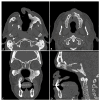Cocaine- and Levamisole-Induced Vasculitis: Defining the Spectrum of Autoimmune Manifestations
- PMID: 39274328
- PMCID: PMC11396482
- DOI: 10.3390/jcm13175116
Cocaine- and Levamisole-Induced Vasculitis: Defining the Spectrum of Autoimmune Manifestations
Abstract
Drug-induced or associated vasculitis is a prevalent form of vasculitis that resembles primary idiopathic antineutrophil cytoplasmic autoantibody (ANCA) vasculitis (AAV). Cocaine is a diffuse psychostimulant drug and levamisole is a synthetic compound used to cut cocaine. Their abuse may result in a spectrum of autoimmune manifestations which could be categorized into three overlapping clinical pictures: cocaine-induced midline destructive lesion (CIMDL), levamisole-adulterated cocaine (LAC) vasculopathy/vasculitis, and cocaine-induced vasculitis (CIV). The mechanisms by which cocaine use leads to disorders resembling AAV are not well understood. Cocaine can cause autoimmune manifestations ranging from localized nasal lesions to systemic diseases, with neutrophils playing a key role through NETosis and ANCA development, which exacerbates immune responses and tissue damage. Diagnosing and treating these conditions becomes challenging when cocaine and levamisole abuse is not suspected, due to the differences and overlaps in clinical, diagnostic, therapeutic, and prognostic aspects compared to primary idiopathic vasculitides.
Keywords: ANCA; CIMDL; CIV; LAC vasculopathy/vasculitis; antineutrophil cytoplasmic autoantibody; cocaine; cocaine-induced midline destructive lesion; cocaine-induced vasculitis; levamisole; levamisole-adulterated cocaine; vasculitis.
Conflict of interest statement
The authors declare no financial support or potential conflicts of interest in this study.
Figures





Similar articles
-
Misdiagnosis of ANCA-Associated Vasculitis in Patients With Cocaine/Levamisole-Associated Autoimmune Syndrome and Cocaine-Induced Midline Destructive Lesions: A Case Series.Immun Inflamm Dis. 2025 Jun;13(6):e70215. doi: 10.1002/iid3.70215. Immun Inflamm Dis. 2025. PMID: 40525737 Free PMC article.
-
[Cocaine-induced vasculitis and mimics of vasculitis].Z Rheumatol. 2023 Sep;82(7):606-614. doi: 10.1007/s00393-022-01217-1. Epub 2022 May 25. Z Rheumatol. 2023. PMID: 35612660 Free PMC article. Review. German.
-
ANCA Associated Vasculitis Secondary to Levamisole-Adultered Cocaine with Associated Membranous Nephropathy: A Case Series.Am J Nephrol. 2017;45(3):209-216. doi: 10.1159/000456553. Epub 2017 Jan 28. Am J Nephrol. 2017. PMID: 28132051
-
NETosis Secondary to the Use of Levamisole-Adulterated Cocaine: A Likely Underlying Mechanism of Vasculopathy.J Toxicol. 2024 Feb 22;2024:7388799. doi: 10.1155/2024/7388799. eCollection 2024. J Toxicol. 2024. PMID: 38434602 Free PMC article.
-
Pulmonary-Renal Syndrome from Levamisole-Adulterated Cocaine-Induced Antineutrophil Cytoplasmic Antibody (ANCA)-Associated Vasculitis: A Systematic Review.Pharmaceuticals (Basel). 2023 Jun 6;16(6):846. doi: 10.3390/ph16060846. Pharmaceuticals (Basel). 2023. PMID: 37375793 Free PMC article. Review.
Cited by
-
Retinal Vascular Complications in Cocaine Abuse: A Case Report and a Literature Review.J Clin Med. 2024 Dec 22;13(24):7838. doi: 10.3390/jcm13247838. J Clin Med. 2024. PMID: 39768763 Free PMC article. Review.
References
-
- Culerrier J., Nguyen Y., Karadag O., Yasar Bilge S., Yildrim T.D., Ögüt T.S., Yazisiz V., Bes C., Celfe A., Yazici A., et al. Characteristics and outcome of ANCA-associated vasculitides induced by anti-thyroid drugs: A multicentre retrospective case-control study. Rheumatology. 2024;63:999–1006. doi: 10.1093/rheumatology/kead319. - DOI - PubMed
Publication types
LinkOut - more resources
Full Text Sources

